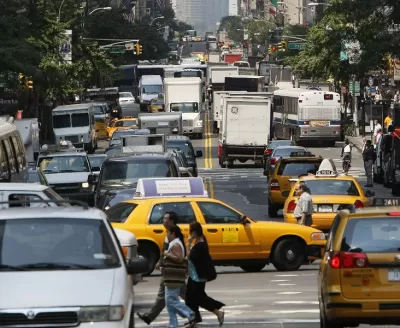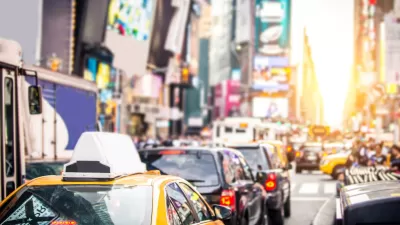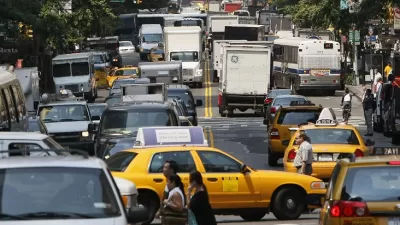The city's plan to charge vehicles entering Manhattan's central business district could reduce traffic and raise $1 billion a year for the city's transportation infrastructure.

In an op-ed in the New York Daily News, Betsy Plum and Kate Slevin argue that New York City's long-awaited plan to institute congestion pricing for vehicles entering Manhattan's central business district is "a welcome milestone" for a strong regional recovery.
"Now that the doors are open for quick action, the MTA should immediately begin determining the nuts and bolts of what New York’s program looks like — fixing how much tolls will cost, whether they’ll vary by time of day, who pays what," write Plum and Slevin. The authors contend that, "[w]ith forward thinking and hard work that starts now," the city could start its program and start earning revenue in as little as a year.
If instituted, the program would follow in the footsteps of London, Singapore, Stockholm, and other traffic-choked cities. "Congestion pricing is projected to raise about $1 billion annually for new subway signals, cars, elevators, buses and commuter rail. It will alleviate congestion worth an estimated $20 billion annually to residents." Additionally, the reduced traffic could lead to faster buses, "quicker emergency response times, less pollution, fewer carbon emissions, less chance of deadly collisions, less of a burden on businesses and customers and less stress for businesses, drivers, commuters and residents."
FULL STORY: Congestion pricing, more than ever

Alabama: Trump Terminates Settlements for Black Communities Harmed By Raw Sewage
Trump deemed the landmark civil rights agreement “illegal DEI and environmental justice policy.”

Study: Maui’s Plan to Convert Vacation Rentals to Long-Term Housing Could Cause Nearly $1 Billion Economic Loss
The plan would reduce visitor accommodation by 25% resulting in 1,900 jobs lost.

Why Should We Subsidize Public Transportation?
Many public transit agencies face financial stress due to rising costs, declining fare revenue, and declining subsidies. Transit advocates must provide a strong business case for increasing public transit funding.

Paris Bike Boom Leads to Steep Drop in Air Pollution
The French city’s air quality has improved dramatically in the past 20 years, coinciding with a growth in cycling.

Why Housing Costs More to Build in California Than in Texas
Hard costs like labor and materials combined with ‘soft’ costs such as permitting make building in the San Francisco Bay Area almost three times as costly as in Texas cities.

San Diego County Sees a Rise in Urban Coyotes
San Diego County experiences a rise in urban coyotes, as sightings become prevalent throughout its urban neighbourhoods and surrounding areas.
Urban Design for Planners 1: Software Tools
This six-course series explores essential urban design concepts using open source software and equips planners with the tools they need to participate fully in the urban design process.
Planning for Universal Design
Learn the tools for implementing Universal Design in planning regulations.
Smith Gee Studio
Alamo Area Metropolitan Planning Organization
City of Santa Clarita
Institute for Housing and Urban Development Studies (IHS)
City of Grandview
Harvard GSD Executive Education
Toledo-Lucas County Plan Commissions
Salt Lake City
NYU Wagner Graduate School of Public Service





























